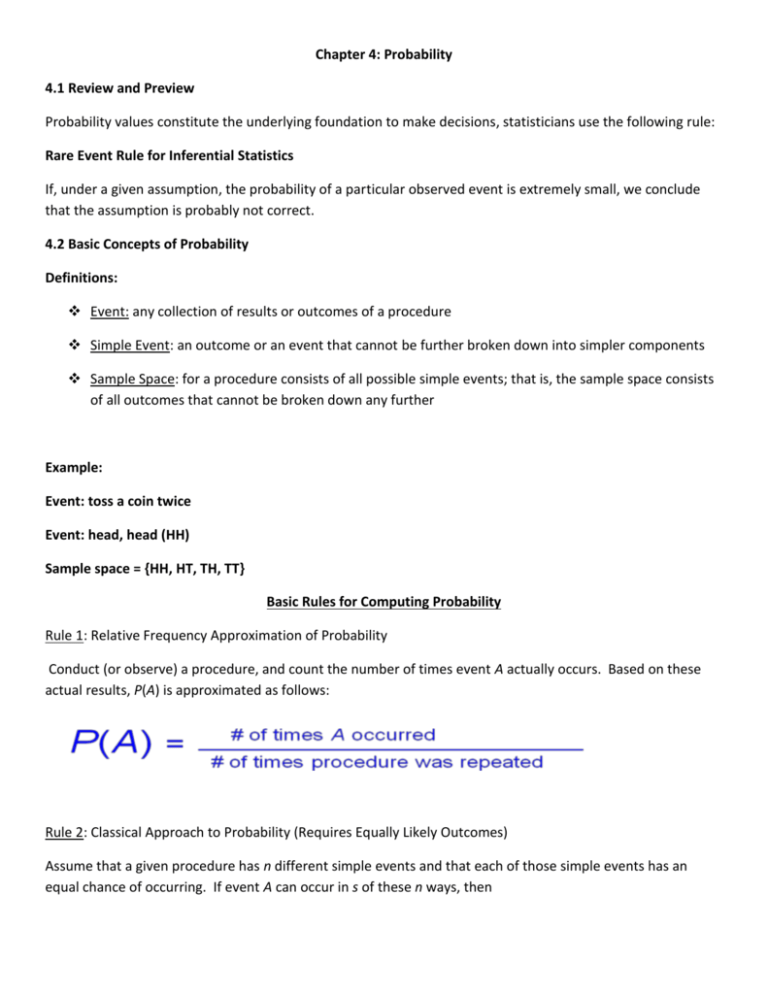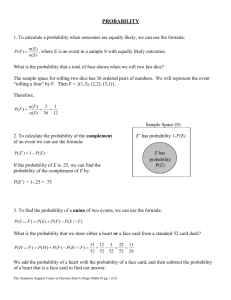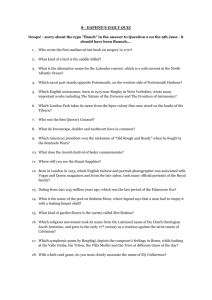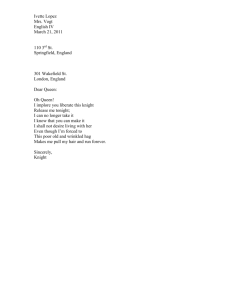triola 5e ch4 notes
advertisement

Chapter 4: Probability
4.1 Review and Preview
Probability values constitute the underlying foundation to make decisions, statisticians use the following rule:
Rare Event Rule for Inferential Statistics
If, under a given assumption, the probability of a particular observed event is extremely small, we conclude
that the assumption is probably not correct.
4.2 Basic Concepts of Probability
Definitions:
Event: any collection of results or outcomes of a procedure
Simple Event: an outcome or an event that cannot be further broken down into simpler components
Sample Space: for a procedure consists of all possible simple events; that is, the sample space consists
of all outcomes that cannot be broken down any further
Example:
Event: toss a coin twice
Event: head, head (HH)
Sample space = {HH, HT, TH, TT}
Basic Rules for Computing Probability
Rule 1: Relative Frequency Approximation of Probability
Conduct (or observe) a procedure, and count the number of times event A actually occurs. Based on these
actual results, P(A) is approximated as follows:
Rule 2: Classical Approach to Probability (Requires Equally Likely Outcomes)
Assume that a given procedure has n different simple events and that each of those simple events has an
equal chance of occurring. If event A can occur in s of these n ways, then
P ( A) =
s
number of ways A can occur
=
n number of different simple events
Rule 3: Subjective Probabilities
P(A), the probability of event A, is estimated by using knowledge of the relevant circumstances.
Law of Large Numbers
As a procedure is repeated again and again, the relative frequency probability of an event tends to approach
the actual probability.
Example:
When three children are born, the sample space is: {bbb, bbg, bgb, bgg, gbb, gbg, ggb, ggg}
Assuming that boys and girls are equally likely, find the probability of getting three children of all the same
gender.
P three children of the same gender
2
0.25
8
Properties of Probabilities
* For any event A, the probability of A is between 0 and 1 inclusive. That is,
* The probability of an impossible event is 0.
*The probability of an event that is certain to occur is 1.
*Possible Values:
0 P( A) 1
Complementary Events
The complement of event A, denoted by
A
, consists of all outcomes in which the event A does not occur.
Example:
1010 United States adults were surveyed and 202 of them were smokers. It follows that:
202
0.200
1010
202
P not a smoker 1
0.800
1010
P smoker
4.3 Addition Rule
Definition: Compound Event any event combining 2 or more simple events
Formal Addition Rule
P (A or B) = P (A) + P (B) – P (A and B)
Where P (A and B) denotes the probability that A and B both occur at the same time as an outcome in a trial of a
procedure.
Example: Find the probably of getting a red card or a king when taking a card from a well shuffled deck of cards
P ( red or king) =
Rule of Complementary Events
P( A) P( A) 1
P( A) 1 P( A)
Definition:
Events A and B are disjoint (or mutually exclusive) if they cannot occur at the same time. (That is, disjoint
events do not overlap.)
Example: getting a king and getting a queen are disjoint, getting a king or getting red are not disjoint.
P( king or queen)=
4.4 Multiplication Rule: Basics
P(A and B) = P(event A occurs in a first trial and event B occurs in a second trial)
P(B | A) represents the probability of event B occurring after event A has already occurred.
P( A and B) P( A) P( B | A)
Example with theoretical probabilities
Find the probability of getting a king first and a queen second when taking two cards from a well shuffled
deck: a) with replacement (independent events) b) with no replacement (dependent events)
a) P(queen and king) = P (queen) x P (king|queen) = 3/52 * 4/52
b) P(queen and king) = P (queen) x P (king|queen) = 4/52 * 4/51
Example with relative frequencies
Suppose 50 drug test results are given from people who use drugs:
Positive Test Results:
44
Negative Test Results:
6
Total Results:
50
If 2 of the 50 subjects are randomly selected without replacement, find the probability that the first person
tested positive and the second person tested negative.
P positive test result for first person
44
50
P negative test result for second person
6
49
P 1st selection is positive and 2nd is negative
44 6
0.108
50 49
4.5 Multiplication Rule: Complements and Conditional Probability
Probability of “at least one”: “At least one” is equivalent to “one or more.”
P(at least one) = 1 – P(none).
The complement of getting at least one item of a particular type is that you get no items of that type.
Example:
Topford supplies X-Data DVDs in lots of 50, and they have a reported defect rate of 0.5% so the probability of a
disk being defective is 0.005. It follows that the probability of a disk being good is 0.995.
What is the probability of getting at least one defective disk in a lot of 50?
P at least 1 defective disk in 50
1 P all 50 disks are good
50
Conditional Probability:
A conditional probability of an event is a probability obtained with the additional information that some other
event has already occurred. P( B | A) denotes the conditional probability of event B occurring, given that event
A has already occurred, and it can be found by dividing the probability of events A and B both occurring by the
probability of event A:
P( B | A)
P( A and B)
P( A)
Example
Refer to the table to find the probability that a subject actually uses drugs, given that he or she had a positive
test result.
Positive Drug Test
Negative Drug Test
Subject Uses Drugs
44 (True Positive)
6 (False Negative)
Subject Does
Not Use Drugs
90 (False Positive)
860 (True Negative)
P subject uses drugs | subject tests positive
P subject uses drugs and subject tests positive
P subject tests positive
44
1000 44 0.328
134
134
1000






